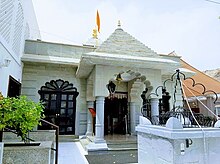Hinduism in the Middle East
[3] Many religions in the Middle East, notable among them is Yazidism, draw heavily from common Indo-Iranian traditions, closely connected to Hinduism.[4] The Yarsani, followers of Yarsanism, believe that the Divine Essence has successive incarnations known as mazhariyyats (similar to the Hindu notion of avatars).[5] At present, there is an influential and wealthy Hindu community, mostly of Indian, Nepalese and Sri Lankan heritage in Arab states of the Persian Gulf.[7] Distribution of Hindus among the Middle Eastern countries Indian settlers came to live in Oman, creating settlements and practicing Hinduism.In the opposite direction, medieval Gujaratis, Kutchis, and other Indians traded extensively with Arab and Somali ports, including Hormuz, Salalah, Socotra, Mogadishu, Merca, Barawa, Hobyo, Muscat and Aden.Arab merchants were the dominant carriers of Indian Ocean trade until the Portuguese forcibly supplanted them at the end of the 15th century.Indo-Arabian links were renewed under the British Empire, when many Indians serving in the army or civil service were stationed in Arab lands such as Sudan.In January 2024, a new Hindu Temple, Dubai opened in Jebel Ali and the existing Shiva Mandir and Gurudwara were moved to this new location.
United Arab EmiratesSaudi ArabiaKuwaitBahrainHinduismBuddhism in the Middle EastSikhismChristianity in the Middle EastHinduism by countryAfricaAngolaBotswanaBurkina FasoBurundiCameroonCentral African RepublicDemocratic Republic of the CongoRepublic of the CongoDjiboutiEritreaEthiopiaGambiaGuineaGuinea-BissauIvory CoastLesothoLiberiaMadagascarMalawiMauritaniaMauritiusMoroccoWestern SaharaMozambiqueNamibiaNigeriaRwandaSão Tomé and PríncipeSenegalSeychellesSierra LeoneSomaliaSouth AfricaSouth SudanTanzaniaTunisiaUgandaZambiaZimbabweAfghanistanArmeniaAzerbaijanBangladeshBhutanBruneiCambodiaCyprusEast TimorGeorgiaHong KongIndonesiaIsraelJordanKazakhstanNorth KoreaSouth KoreaKyrgyzstanLebanonMalaysiaMaldivesMongoliaMyanmarPakistanPalestinePhilippinesSingaporeSoutheast AsiaSri LankaTaiwanTajikistanThailandTurkeyTurkmenistanUzbekistanVietnamEuropeAndorraAustriaBelarusBelgiumBosnia and HerzegovinaBulgariaCroatiaCzechiaDenmarkEstoniaFinlandFranceGermanyGibraltarGreeceHungaryIcelandIrelandKosovoLiechtensteinLithuaniaLuxembourgMoldovaMonacoMontenegroNetherlandsNorth MacedoniaNorwayPolandPortugalRomaniaRussiaSerbiaSlovakiaSloveniaSwedenSwitzerlandUkraineUnited KingdomEngland


